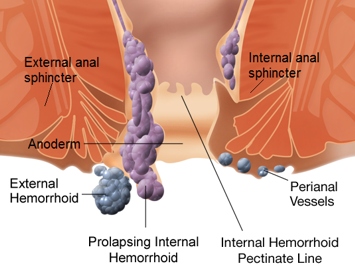Haemorrhoids
Hemorrhoids are vascular structures in the anal canal which help with stool control. Hemorrhoids are considered as a typical civilization disease. As many as 60% of population suffer on hemorrhoids. Incidence of disease is 8%, prevalence is 10%. Men suffered from hemorrhodis more frequently than women (4:1). They become pathological or piles when swollen or inflamed. In their physiological state they act as a cushion composed of arterio-venous channels and connective tissue that aid the passage of stool. The symptoms of pathological hemorrhoids depend on the type present. Internal hemorrhoids usually present with painless rectal bleeding while external hemorrhoids present with pain in the area of the anus.
There are two types of hemorrhoids, external and internal, which are differentiated via their position with respect to the dentate line.
External hemorrhoids are those that occur outside the anal verge (the distal end of the anal canal). Specifically, they are varicosities
of the veins draining the territory of the inferior rectal arteries, which are branches of the internal pudendal artery. They are sometimes painful,
and often accompanied by swelling and irritation. Itching, although often thought to be a symptom of external hemorrhoids, is more commonly due
to skin irritation. External hemorrhoids are prone to thrombosis: if the vein ruptures and/or a blood clot develops, the hemorrhoid becomes
a thrombosed hemorrhoid.
Internal hemorrhoids are those that occur inside the rectum. Specifically, they are varicosities of veins draining the territory of branches
of the superior rectal arteries. As this area lacks pain receptors, internal hemorrhoids are usually not painful and most people are not aware
that they have them. Internal hemorrhoids, however, may bleed when irritated. Untreated internal hemorrhoids can lead to two severe forms
of hemorrhoids: prolapsed and strangulated hemorrhoids. Prolapsed hemorrhoids are internal hemorrhoids that are so distended that they are pushed
outside the anus. If the anal sphincter muscle goes into spasm and traps a prolapsed hemorrhoid outside the anal opening, the supply of blood is
cut off, and the hemorrhoid becomes a strangulated hemorrhoid.
- Internal hemorrhoids can be further graded by the degree of prolapse.
- Grade I: No prolapse,
- Grade II: Prolapse upon defecation but spontaneously reduce,
- Grade III: Prolapse upon defecation and must be manually reduced,
- Grade IV: Prolapsed and cannot be manually reduced.
Signs and symptoms
- Hemorrhoids usually are present with:
- itching
- rectal pain
- rectal bleeding
Causes
- A number of factors may lead to the formations of hemorrhoids including:
- irregular bowel habits (constipation or diarrhea),
- exercise,
- nutrition (low-fiber diet),
- increased intra-abdominal pressure (prolonged straining),
- pregnancy,
- genetics,
- absence of valves within the hemorrhoidal veins,
- aging.
- Other factors that can increase the rectal vein pressure resulting in hemorrhoids include:
- obesity and
- sitting for long periods of time.

Altoven line is successfully used as a part of Conservative treatment of hemorrhoids.
Prevention and cure
- The best way to prevent hemorrhoids is:
- to keep stools soft so they pass easily, thus decreasing pressure and straining,
- to empty bowels as soon as possible after the urge occurs.
- Exercise, including walking, and increased fiber in the diet help reduce constipation and straining by producing stools that are softer and easier to pass.
- Spending less time attempting to defecate and avoiding reading while on the toilet have been recommended.
- Cure:
- Conservative treatment typically consists of nutrition rich in dietary fiber, uptake of oral fluids to maintain hydration, non-steroidal anti-inflammatory drugs (NSAID)s, sitz baths, and rest.
- Procedures like rubber band ligation is typically recommended as the first line treatment in those with grade 1 to 3 disease. Sclerotherapy involves the injection of a sclerosing agent, such as phenol, into the hemorrhoid. A number of cauterization methods have been shown to be effective for hemorrhoids, but are usually only used when other methods fail.
- A number of surgical techniques may be used if conservative management and simple procedures fail. All surgical treatments are associated with some degree of complications including bleeding, infection, anal strictures and urinary retention, due to the close proximity of the rectum to the nerves that supply the bladder.


